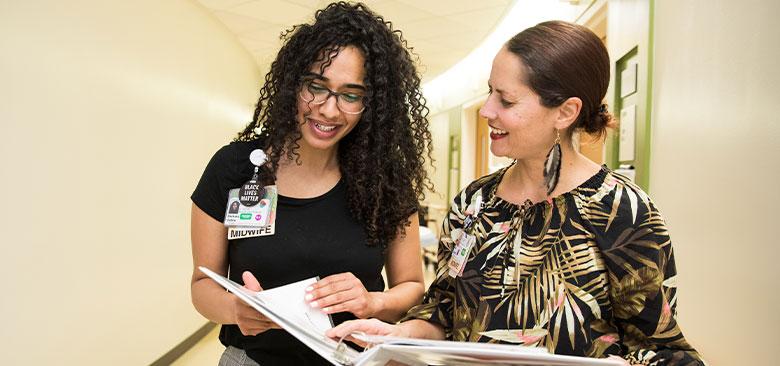
Asmara Gebre (left), nurse midwife at Zuckerberg San Francisco General Hospital, and Ana Delgado, director of inpatient midwifery services at ZSFGH, are addressing racism in pregnancy and birth care.
How Nurse-Midwives Can Fill Gaps in Patient Care
A recent report from the American Congress of Obstetricians and Gynecologists estimates that the state’s female population will increase 22.6 percent by 2030, yet the number of obstetrician-gynecologists will decline. Nurse-midwives could help fill this void, but decades-old regulations are restricting them from truly fulfilling their mission.
Despite these legislative roadblocks, the UCSF School of Nursing’s faculty and alumni are leading research to draw attention to the challenges and making improvements to patient care.
Examining the Effects of An “Archaic” Law
A 1974 amendment to California’s Nurse Practice Act requires that nurse-midwives practice under the supervision of a physician or surgeon. California is one of only four U.S. states with this requirement. All other states allow nurse-midwives to practice as independent providers or with a collaboration agreement with a physician.
“It’s really an archaic law,” said Kathleen Belzer (MS ’93), president of the California Nurse-Midwives Association. “It’s mind-boggling that things have not changed in all these years.”  Kathleen Belzer
Kathleen Belzer
Nurse-midwives are registered nurses equipped to provide prenatal through newborn care, as well as family planning services. They can conduct physical examinations, prescribe medications, perform certain procedures, and order and interpret laboratory and diagnostic results.
 Kim Dau “They’re an underutilized workforce,” said Kim Dau, associate clinical professor and director of the UCSF School of Nursing’s Certified Nurse-Midwife/Women’s Health Nurse Practitioner specialty. “Nurse-midwives are prepared to be independent providers with a scope of practice that is a subset of physicians. We’re able to provide services that don’t necessarily require a physician to provide.”
Kim Dau “They’re an underutilized workforce,” said Kim Dau, associate clinical professor and director of the UCSF School of Nursing’s Certified Nurse-Midwife/Women’s Health Nurse Practitioner specialty. “Nurse-midwives are prepared to be independent providers with a scope of practice that is a subset of physicians. We’re able to provide services that don’t necessarily require a physician to provide.”
Women cared for by midwives are less likely to have cesarean births, have similar health outcomes to those cared for by physicians, and report greater satisfaction with their care, according to a paper co-authored by Dau and Joanne Spetz, a School of Nursing professor and associate director at Healthforce Center at UCSF, along with the California Health Care Foundation.
“There is no evidence that it [supervision requirement] adds safety or value to the patient,” Spetz said. “And that should be the litmus test: The true value to mommas  Joanne Spetz and babies.”
Joanne Spetz and babies.”
The supervision requirement can be especially burdensome for nurse-midwives practicing in rural areas where the need is often greater.
“Black individuals and individuals from marginalized communities have more adverse maternal and neonatal outcomes. Midwives have historically taken care of these communities,” Belzer said. “These are the individuals who often don’t have a voice and the ones who stand to gain the most when we remove barriers to midwifery care.”
Belzer said a bill to nullify the requirement is expected to again be introduced in the state legislature this year. It would be the fourth time in five years a similar bill has been introduced.
Alumni Making an Impact
Despite the barriers, UCSF midwifery alumni have made strides, especially in implementing new policies and procedures, addressing racism in pregnancy and birth care and serving the underserved.
Ana Delgado (MS ’02), assistant director of inpatient obstetrics and director of inpatient midwifery services at Zuckerberg San Francisco General Hospital (ZSFGH) is educating hospital personnel about the impact of interpersonal, institutional and structural racism.
“We’re turning the lens on racism rather than race,” Delgado said. “It’s upsetting to hear that black women are three to four times more likely to die during childbirth. How can we provide respectful care and create an identity-safe environment? Are we asking the right questions of ourselves, the institution and our health care system?”
To examine structural racism, Delgado organizes presentations and “action lunches,” where small groups of professionals discuss these issues. She regularly engages with community leaders, especially those representing black and indigenous women, to understand their needs.
Asmara Gebre (MS ’17), a certified nurse-midwife at ZSFGH, is passionate about providing care to pregnant people, including those with substance use disorders. A clinical experience last year reinforced her motivation to serve this population.
A new client to Gebre’s care required a refill of buprenorphine, but Gebre – as well as other health care providers in the clinic that day – did not have prescribing rights. Thanks to the collaborative efforts of the maternity care team at ZSFGH, the client safely continued her treatment course, but Gebre “felt at a loss” during that episode due to the prescribing restrictions.
“Midwifery is a profession that specializes in holistic care which can include substance use treatment,” Gebre said. “During pregnancy people should have options as to what kind of care they receive, and everyone deserves access to midwifery care, especially if they have normal pregnancies.”
Thanks to the SUPPORT Act, which provides nurse-midwives prescribing authority for controlled substances after undergoing training, Gebre now can prescribe medication-assisted therapy for substance use disorder.
 Marcy Ronneberg Marcy Ronneberg (MS ’07), assistant chief nurse-midwife at Kaiser Permanente North Valley, is helping spearhead changes to Kaiser’s fetal surveillance policy to make intermittent auscultation (IA) available as an option for low-risk patients.
Marcy Ronneberg Marcy Ronneberg (MS ’07), assistant chief nurse-midwife at Kaiser Permanente North Valley, is helping spearhead changes to Kaiser’s fetal surveillance policy to make intermittent auscultation (IA) available as an option for low-risk patients.
IA is a form of monitoring in which a fetus’ heart rate is monitored intermittently using a handheld doppler rather than with continuous electronic fetal monitoring. Some patients prefer laboring without belts and monitors on their bellies. The use of IA can help facilitate upright positions, movement and other coping options during labor and may help labor progress more normally.
“Providing patients with options, engaging them in a shared decision-making model of care and supporting physiologic labor are all core values of midwifery,” Ronneberg said.
Ronneberg spent several years researching IA, helping develop training for nurses and formulating hospital policy on the practice. The initiative was a good example of the kind of multidisciplinary efforts currently taking place at Kaiser to support intended vaginal birth and patient birth preferences, she said.
Kaiser has long recognized the value of integrating nurse-midwives into maternity care, Ronneberg said. In addition to being cost-effective, advanced care providers, many studies have shown that patients receiving midwife-led care are less likely to experience intervention, more likely to have a spontaneous vaginal birth and more likely to be satisfied with their care.
Because of their skills and expertise, Kaiser has incorporated nurse-midwives into local and regional leadership roles, Ronneberg said.
“At Kaiser Roseville, the midwifery chief and I have a seat at the table for most of the decisions we make as a department,” she said. “That has given us the opportunity to work collaboratively with our physician colleagues to promote positive changes within the system.”
Focus on Health Disparities
The School of Nursing’s midwifery specialty is one of two in California approved by the Board of Registered Nursing (CSU Fullerton is the other) — a fact that’s drawing students to the School, Dau said.
Master’s student Jasmin Johnson has been a nurse for five years and estimates she has attended 200 to 300 births. The opportunity to achieve a dual degree — certified nurse  Jasmin Johnson midwife/nurse practitioner — and treat women from adolescence to post-menopausal stages drew her to the specialty, but she has appreciated the knowledge in social and reproductive justice that she’s gaining in the training.
Jasmin Johnson midwife/nurse practitioner — and treat women from adolescence to post-menopausal stages drew her to the specialty, but she has appreciated the knowledge in social and reproductive justice that she’s gaining in the training.
“I learned about disparities among African American women and infants, how disparate the outcomes are, how deeply rooted racism is within health care, and the effects those things have on patients,” Johnson said. “I want to be a catalyst for change and help improve birth outcomes for marginalized patients, their babies and their families.”



